7 cold email statistics that can refine your engagement strategy
COLD EMAIL.
an unsolicited e-mail that is sent to a receiver without prior contact; the email equivalent of cold calling
Wikipedia nails it; however, the Urban Dictionary definition is (unfortunately) sometimes more accurate.
But just blasting out cold email after cold email without a plan, without direction, without heeding our advice (based on data), would be silly … no matter what Oprah says:
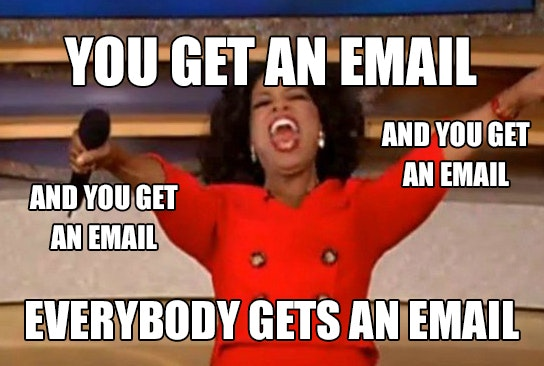
Fortunately, I have some good news: Cold emails still work. And we have the data to prove it.
Below are 7 cold email stats that will help ensure your soon-to-be new client opens your email and responds (positively). Oh, and that you close more deals (what really matters).
Wait. Tell me more about this data.
But wait. Before we dig into the details, allow me to tell you more about how we get sales stats like these.
Gong captures (anonymized, of course) data from our customers – web conference meetings, phone calls, and emails – and uses AI to analyze how seller and buyer behavior impacts success rates.
Need a visual? It looks like this (kinda):

We analyzed millions of cold emails for these cold email stats to uncover what works and what doesn’t.
Here is what we found.
Cold Email Stat #1: DO send longer emails
I know. I know. I KNOW.
This one seems counterintuitive. After all, humans have a shorter attention span than goldfish.
But hear me out.
A short email and a concise email are not necessarily the same. Short emails focus on length, say 30 or fewer words. A concise email is both about the number of words AND the meaning.
A concise email can be brief but must contain value and be clear. So it’s perfectly fine – and preferred – to craft a 150+ word email (somewhat longer) that provides the prospect value yet is still succinct and well-crafted.
The data prove it out – longer emails are significantly more effective in booking a meeting:
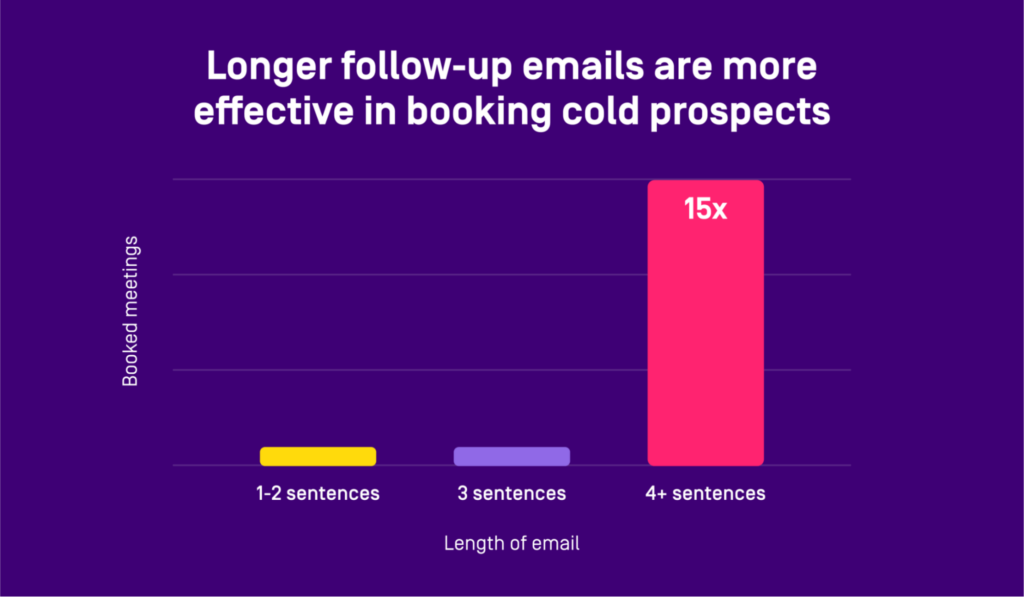
In this case, we define “longer” as 30-150 words. These emails must include information that connects the prospect or their company to your offer. A longer email works if your email is personalized, direct, and intentional in every sentence.
This confirms our cold call stats: Talking MORE on cold calls yields BETTER results than other types of calls. Same goes for email. Cold outreach is it’s own beast, treat it as such.
Not sure where to start?
I put together these cold email templates using data from Gong and the best-performing emails we’ve ever sent. They’re 0% opinions, 100% reality (and 100% irresistible).
Cold Email Stat #2: DON’T talk ROI
In many cold call sales 101 workshops, we are taught to include ROI in your pitch. Give them some hard data to connect with!
And it makes sense. Sharing the “amazing results” your prospect is “sure to get” by using your solution feels like the right thing to do.
WRONG.
The Gong data doesn’t lie: Using ROI language in cold emails decreases success rates by 15%.
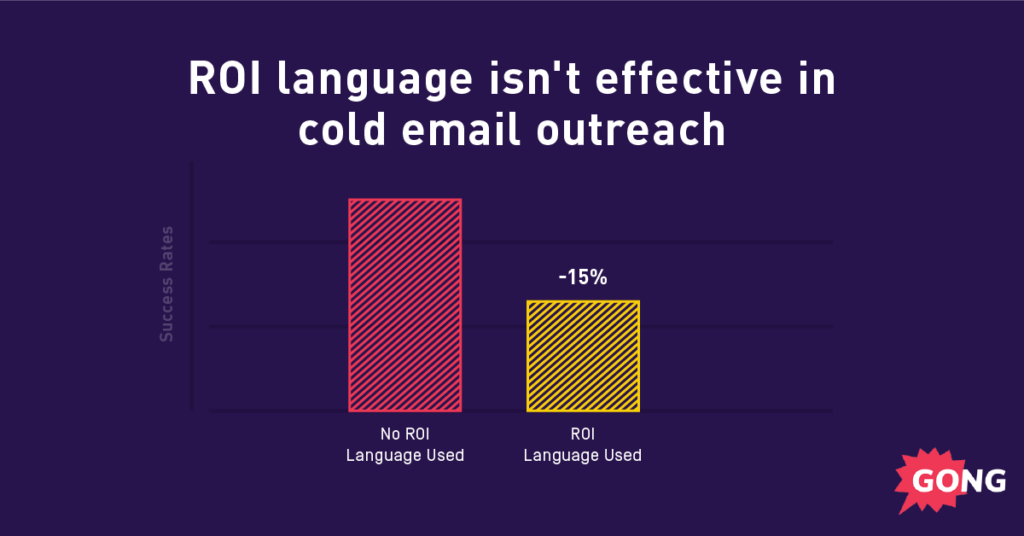
Here’s why: There is a difference between believability and effectiveness, especially when talking about ROI. Your prospects may believe the data (a good thing), but they may not find them compelling enough to book a meeting (not a good thing).
By blurting out ROI figures, you are starting with the end result without providing context … without sharing the actual problem your solution solves for.
Your ROI claims are floating on an island by themselves – disconnected from the prospect’s reality. It’s just a number. A stat. A data point.
To be clear, there is a time and a place for sharing ROI, just not in the cold email.
REMEMBER: Buyers make decisions based on emotions, then justify their decision with logic (see: ROI).
Cold Email Stat #3: DO use the “Interest CTA”
When it comes to cold email calls to action (CTA), they generally fall into 3 buckets:
(1) Specific CTA: Asks for a meeting using a specific day and time. Like, “Can you chat Friday at 2 PM PT?”
(2) Open-ended CTA: Asks for a meeting, but is open-ended (not bound by a day/time). Like, “Do you have time later this week to connect?”
(3) Interest CTA: Asks for interest, not a meeting. Like, “Are you interested in learning more about X?”
They all have their time and place, but when it comes to cold emails, there is a clear winner:
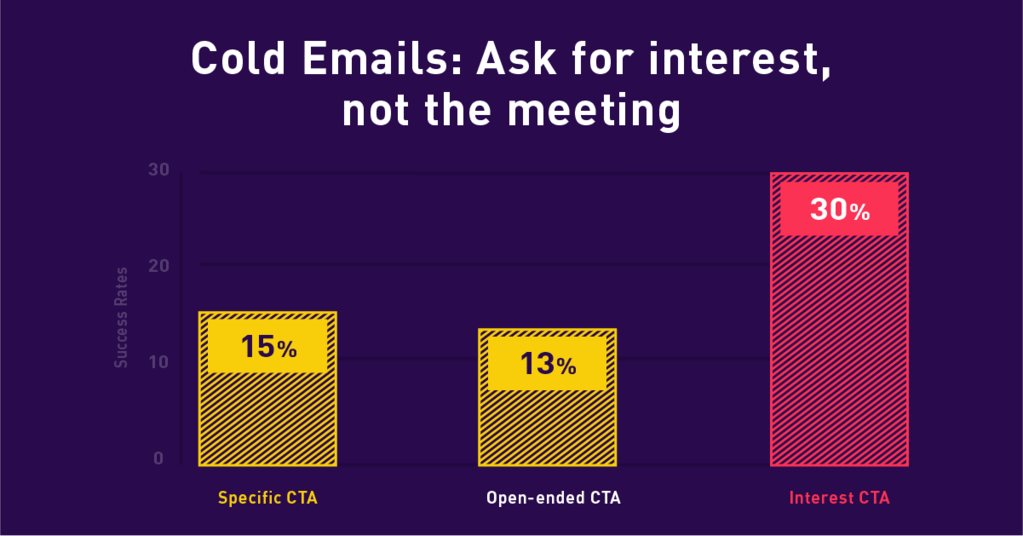
The Interest CTA is the highest performing call to action for cold emails.
You see, when you are asking for interest, you are selling the conversation, not the meeting.
When you focus on the meeting, you are essentially asking for the prospects’ time – a finite resource. And the buyers you are targeting with your cold email outreach know all about time, something they wish they had more of!
Why would someone (a person who doesn’t know you) give away their time?
Interest is not finite. Interest is not a resource. Interest is … interest.
As sellers, we are better off tapping into a buyer’s curiosity instead of asking for a finite resource like time right out of the gate.
Get interest locked up, then move on.
And while you are here, grab yourself a (free) copy of our 43 CTAs for Highly Effective Emails.

Cold Email Stat #4: DON’T ask for “thoughts.”
You THINK you are engaging.
You THINK you are conversational.
You THINK you are going to get a positive reply.
Asking a buyer for their “thoughts” in a cold email seems like the intelligent approach. Unfortunately, it’s a “sneaky” way of soliciting a reply (hopefully one that doesn’t include GO AWAY AND LEAVE ME ALONE).
Generally speaking, asking for someone’s opinion can be effective as it taps into the human need to be heard.
But when it’s used to get a reply from a prospect in a cold email, asking for “thoughts” is just a gimmick.
While including this word may increase reply rates, it dramatically decreases your chances of booking a meeting … by 20%:
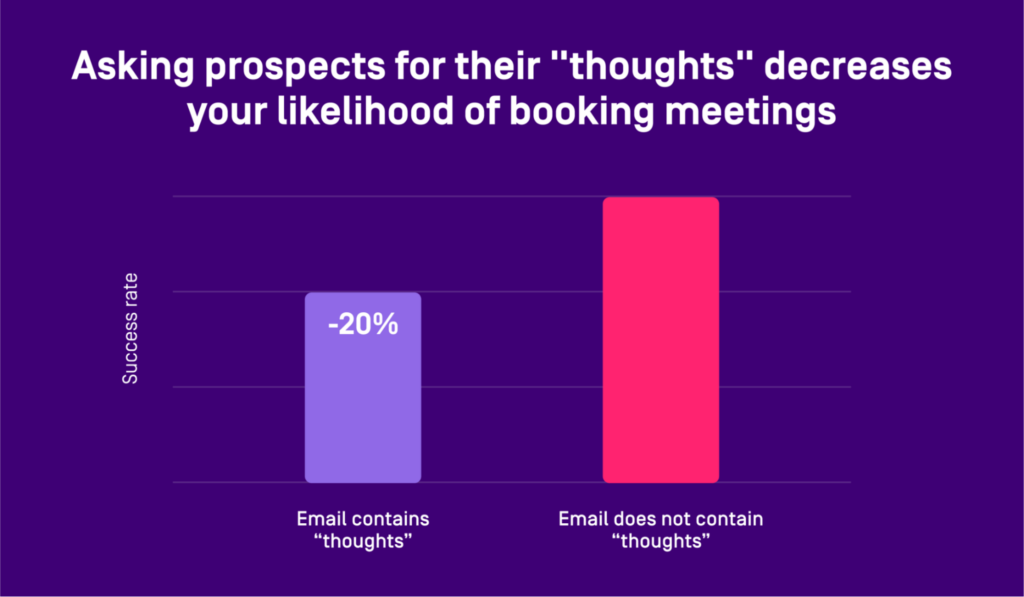
Trust the data (the reality).
Cold Email Stat #5: DON’T guilt buyers
If I had a nickel for every time I got a cold email that made me feel guilty…
You know what I’m talking about. You’ve done it. I’ve done it. We – all sellers – have done it.
We’ve used phrases like “I never heard back” in cold email outreach follow-up emails.
While this wording increases reply rates, it decreases meetings booked by 14%.
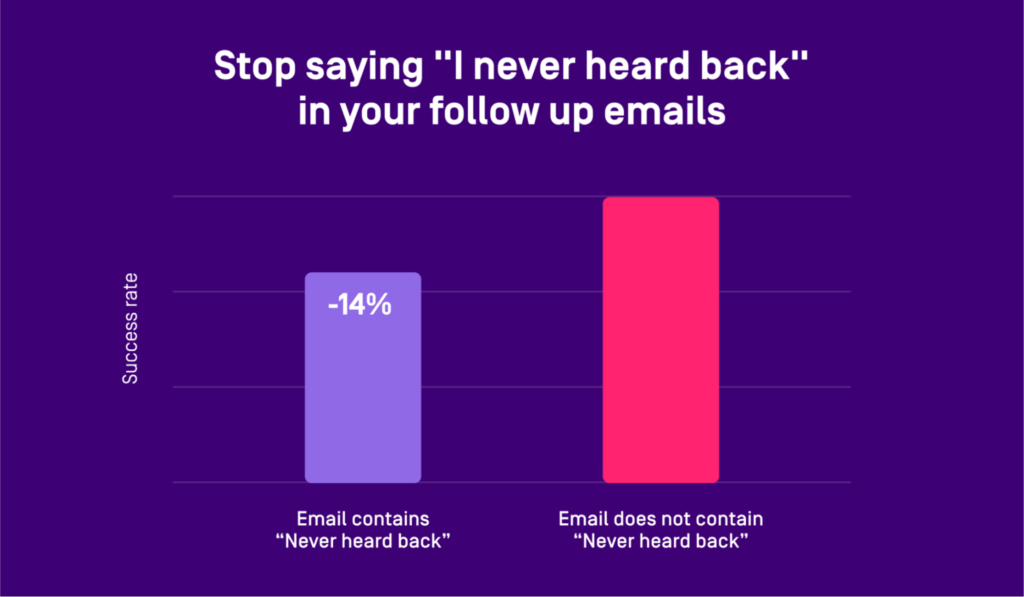
And let’s be honest, the goal of a cold email is to book a meeting. Replies may give you the warm fuzzies, but replies don’t (necessarily) move deals through the pipeline.
By writing, “I never heard back from you,” you are creating one of two emotional responses from the buyer (spoiler alert: neither are positive):
- GUILT: Yikes. That’s not an emotion you want to push on anyone, let alone a possible buyer! Sure, you are frustrated. You’ve logged some time and effort doing your homework, sending an email, calling, connecting with them on LinkedIn, and nothing. Hard fact: Buyers don’t care! Don’t make them feel guilty.
- CONFIRMATION: They were never into you. They were not going to reply. “I never heard back from you” just confirms all of that. It may prompt a “No, thanks,” but it’s not likely to book a meeting.
Instead …
Cold Email Stat #6: DO use a “nicety.”
Be nice. Be kind.
I’m all for both!
But when I see “Hope all is well” in a cold email, I cringe.
I do not like it. At all.
Don’t waste my time – just get to the point. Tell me why you’re emailing me.
But guess what? IT WORKS.
The phrase “Hope all is well” correlates to increased meetings booked by an impressive 24%!
Counter-intuitive:
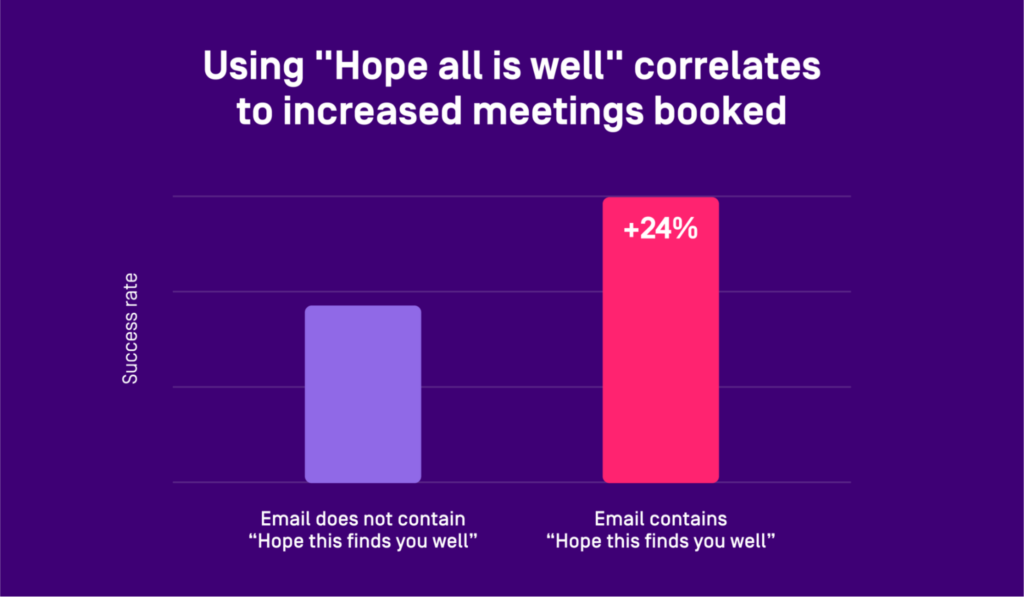
Want to level up your “hope all is well” messaging? Make it less generic by personalizing it a bit.
Like this: “Hey Sue, I hope all is well since your massive rebranding effort. I’m sure it was a busy few months!’
Adding this bit shows you are paying attention and helps to build trust. It also proves you are not sending an automated email blast reply thing.
Cold Email Stat #7: DON’T reference your call
A standard cold email outreach sequence rolls like this:
Call #1.
Email #1.
Email #2.
Call #2.
In Email #2, we’ve been taught to include a phrase like, “I just left you a voicemail” or “I just tried to call you.”
That seems like – feels like – the most natural approach, the most logical introduction to your first email. It’s a connection point (you have heard my voice before).
But (again), the data does not lie.
Mentioning your call or the fact you left a voicemail does not lead to more meetings booked.
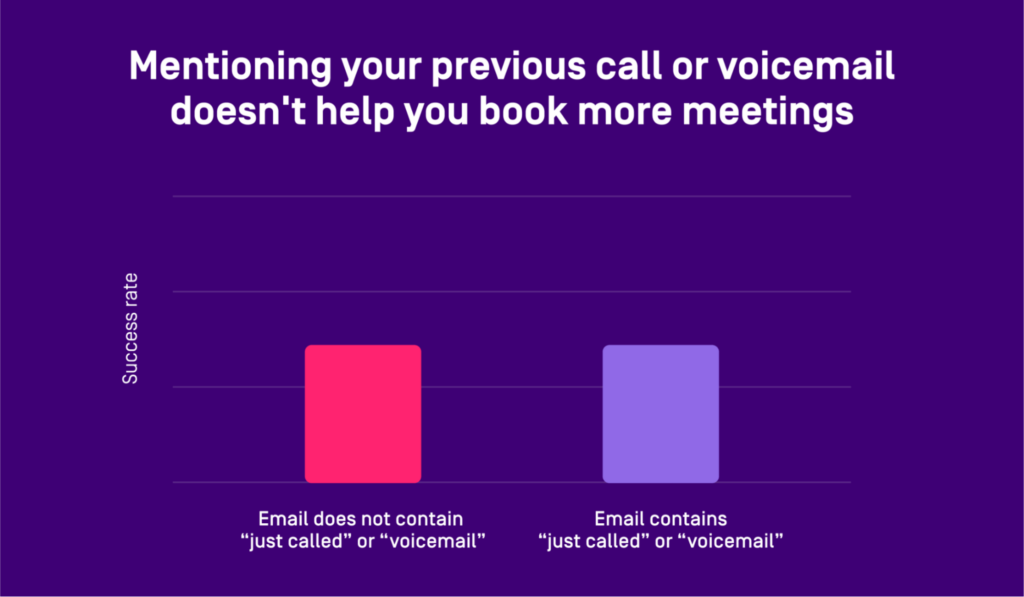
That phrase does nothing to move the needle in your favor. Nada. Zilch.
As it turns out, buyers don’t care how much effort you’ve put forth. Duh. They care about themselves (again, duh). We all do.
Stop telling them what you’ve done and the effort you are exerting to reach them. Instead, focus on the value – why should they take your call or reply to your meeting.
Bring the value!
Grab our 3 Highly Effective Cold Calling Scripts.
7 cold email stats AND 11 highly persuasive (sales email) templates?
Why yes.
While we’ve spent the last few minutes discussing cold email stats, those are not the only emails we send as sales reps.
FAR FROM IT.
There are also:
- Cold (prospecting) emails
- Follow-up emails
- Multi-threading emails
- Negotiating emails
- Closing emails
To name a few.
We built these fill-in-the-blanks sales email templates to help guide you through the process and, ideally, book more meetings and win more deals.
Grab ‘em. And go after it. Persuade. Close some deals!


